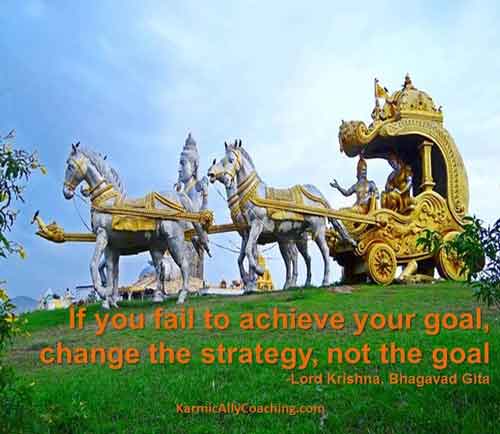This post has already been read 3959 times!

The Bhagavad Gita is a source of spiritual Life Coaching while providing essential lessons for leaders and those who want to follow the Path of Dharma or Duty, whether in their personal or professional lives.
Maharishi Mahesh Yogi has described the Bhagavad Gita as the essence of Vedic Literature and a complete guide to practical life.
Most people who have heard of this sacred text know that the Bhagavad Gita or The Celestial Song, was preached on the battlefield by Krishna, the eighth avatar of Lord Vishnu to Arjuna, the Leader, motivating him to do his duty as he faltered on seeing his friends and relatives who were now his enemy at the battle of Kurukshetra even as multitudes of his warriors stood behind him, waiting for him to lead them to victory in the Hindu epic Mahabharata.
The views that follow is my own based on my reading of the epic Mahabharata and the Bhagavad Gita.
Each time I read both, I discover something new or have a realization. There is much depth and knowledge hidden in the pages of the Bhagavad Gita that are being revealed to me as I progress on my own spiritual path.
Divine Coaching from Lord Krishna
It’s my belief that Arjuna received divine coaching from none other than Lord Krishna himself.
Reading the scriptures carefully, one realizes it has all the tools for self-coaching, maintaining one’s mental equilibrium and focus when faced with a goal that may appear insurmountable.

The Gita is a gospel of Karma-Yoga
Lord Krishna explains how performance of prescribed duties, but without attachment to results, is the appropriate course of action for Arjuna. By the time the discourse is completed, the coached Arjuna becomes a Karma Yogi and unstoppable Leader of his army.
Swami Krishnananda explains it beautifully is his discourse The Principles of the Bhagavad Gita. He describes the main gospel of the Bhagavad Gita as Karma-Yoga, because it converts every activity into a meditation on the Absolute.
The Bhagavad Gita teaches that worldly activity is itself a spiritual activity in the end, because any activity is finally inseparable from the movement of the Absolute. Therefore, it is, in truth, spiritual activity.
Reading and understanding the Bhagavad Gita is truly a powerful and intense catalyst for personal transformation.
Spirituality as a hallmark of a true Leader
Core values bind a team, not a collection of core competencies.
While many may believe the Gita to be a purely spiritual text, there are in fact tips and guidance for Leadership, whether over oneself or over a team and the need for integrity and focus on our goal.

Interestingly, at the beginning of the Holy Scripture, we learn that Duryodhana, the Crown Prince of Hastinapur undertakes an analysis of his strengths and weaknesses as well as those of the Pandavas, his enemy before the battle begins.
Arjuna does the same but shares his trepidation and fears with Lord Krishna. He is open to receiving guidance from the Higher Source which leads to ultimate victory in the greatest battle of its time on earth.
The might of Duryodhana’s army comprises the greatest warriors, kings whose very names can strike terror in the heart of any enemy.
It is headed by the venerated Bhishma, who is in every way a Leader projecting Gravitas. Yet he feels insecure and not confident of defeating the Pandava army. He asks his warriors to protect Bhishma.
Perhaps Duryodhana realizes that his huge army lacks the motivation and inner fire that is present in the army of the Pandavas who are fighting for justice.
The allegiance of his army is more out of a mistaken sense of loyalty to him rather than for the good of Hastinapur. The core values that bind a team together are either not strong enough for the warriors to identify with or are missing.
Each great warrior knows that the enemy is right but still they are willing to side with Duryodhana because of past benefits which blind them from being their true selves.
This happens a lot in today’s world where battles of corporate politics are fought at different levels.
Duryodhana knows this all too well which is why he asks his men to rally around and protect their Commander in Chief Bhishma, who is a symbol of virtue and respected by both sides.
He is the one good value that can bind Duryodhana’s de-motivated men together and aid in achieving his goal of retaining Hastinapur for him.
During the battle, when Bhishma is wounded and lying on a bed of arrows he continues to hold onto life until his vow that Hastinapur will be secure is completed. This happens with the victory of the Pandavas and justice.
In all humility, the only analysis that I can offer is that when there is courage of conviction and a strong belief that one is on the right path, then no matter what the impediments and obstacles come in our way, our Inner Fire will keep us going towards the highway of Success.
Turning inwards to our Higher Source strengthens our resolve and provides the spiritual support required to move forward.
At the same time, often even with the bad, there is some good and if the fight is for a just cause, then flame of virtue continues to flicker waiting for truth and justice to emerge, even if it is surrounded by other factors. In this case Virtue in the form of Bhishma waited for Righteousness to secure Hastinapur, the ultimate Goal.
How do you ensure alignment of your activities with your core values as a Leader to your team?
Author Note: This post is referenced to the Hindu epic Mahabharata and the Bhagavad Gita. Explore the epic and lessons for modern day Leadership as well as the spiritual way of life with 2 recommended books.
Timeless Leadership: 18 Leadership Sutras from The Bhagavad Gita by Debashis Chaterjee
Bhagavad-Gita English (2013) by A. C. Bhaktivedanta Swami Prabhupada
Image of Lotus Flower courtesy Mark Yang






 I adhere to the Certified Coaches Alliance Code of Ethics and Standards. A copy is available on request.
I adhere to the Certified Coaches Alliance Code of Ethics and Standards. A copy is available on request.
 Let's Talk through the Connect Form:
Let's Talk through the Connect Form:
So true, Vatsala. Each time we read a treasured text, we learn more and understand more. While it may be the goals in our everyday life or the loftier goals of raising human consciousness, it is the direction we must always be moving in.
Very true, Joyce. Our journey towards our goals is smoother when we walk with integrity, authenticity and practice our core values.
Your blog is beautifully written and the quotes and pictures are magical. It contains so much inspiration for true leadership. Thank you. Sharing.
Thank you for your kind words, Kathleen. You’ve made my day!
This one is resonating in my heart: “If you fail to achieve your goal, change your strategy, not the goal.” Yes, and yes!
Absolutely Sue. 🙂 That’s a lesson I learned from Miss Coco and wrote about her problem solving tips in this blog post
Very inspiring and eye-opening. Thank you so much for sharing. 🙂
Thank you Marquita!
I love this post. Being an Indian I know that the teachings of Bhagvad Gita are mythological stories that you grow up with. I remember watching sunday cartoons of the stories from Gita. Now being on a spiritual path myself I can relate to the importance of core values and virtues in being true to our sacred purpose on this planet. A good example of leadership.. thank you for sharing 🙂
My pleasure, Jonita. We often hear stories as children that have a deeper meaning in addition to being entertaining stories. We learn the true lessons as we progress in life and have experience under our belt that enables us to experience the true teaching of the story.
Beautiful way to view leadership. Thanks for sharing! xoxo
Thanks Natasha.
I love the quote you share:”If you fail to achieve your goal, change the strategy, not the goal.” It resonates with my ‘bumper sticker’ approach to life – to know what’s important, and remain flexible in the application of adherence to that guiding principle or goal.
I enjoyed this post. All great spiritual texts have so much wisdom to offer us!
Thanks Reba. The Bhagavad Gita has many philosophical and motivational quotes that make life easier if we follow them. You are right about the great spiritual texts and wisdom. Many of them are saying the same thing even if the language or context is changed. It’s time for humanity to wake up and smell the coffee. 🙂